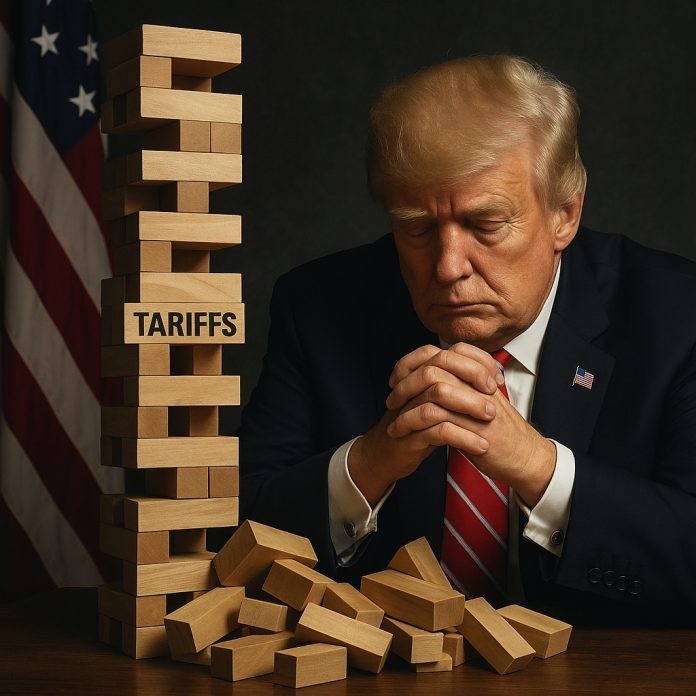By Brecht Jonkers
The United States, in a typical case of late imperial power play politics that often accompanies the decline of corrupt world powers, has aggressively increased tariffs on virtually every country in the world, but particularly targeted China. Officially, this is done in a desperate bid to ensure that the US economy remains competitive globally, and to ensure a steady US productive industrial capacity, which has been steadily declining over the past decades.
If that is indeed the real goal, it seems to have failed spectacularly so far. It has succeeded only in driving up prices, increasing inflation, causing high-risk volatility on the US bond market and pushing small businesses in the US to the brink of bankruptcy.
Paradoxically, some of the worst hit sectors suffering from US tariffs are precisely the popular and modern ones, such as e-commerce and dropshipping business. As reciprocal tariffs are paid directly by the importer into the US, businesses have no choice but to either take a direct financial hit, or increase their sales prices in order to retrieve some of the costs. A group of small business owners even sued the Trump regime demanding the removal of tariffs, but lost the case in federal court.
Financial firm JPMorgan warned that the longer-term inflation and lowering of purchasing power that comes with it, has a good chance of causing a recession in the US later this year.
One of the ironies of liberal capitalism is that the major powers that generally push it through globally, end up being the victims of unshackled forces of greed and profit maximization that it unleashes as a general rule. It happened to Europe in the decades after World War II, when the United States took over as global hegemon from Britain, and profit-seeking corporations increasingly began moving their production facilities elsewhere. The merciless logic of the free market “forces” even the most well-meaning corporate entrepreneurs to cut costs and maximise profit at any cost, or risk being out-competed and bankrupted in the rat race of competition.
This has been an ongoing problem for decades all across the west. The European Trade Union Institute reported in 2024 that the EU alone had lost almost a million jobs in the productive industrial sector (the sector that actually produces material goods) in just four years. The European Commission itself has estimated that the global share of industrial output by the EU had fallen from 27% in the year 2000 to merely 16% of worldwide production by the year 2014. This trend has continued since then, ten years ago.
Despite claims to American exceptionalism, the US has suffered a similar decline in industrial production since its zenith. The Bureau of Labor Statistics estimates that since the peak of US industrial capacity in 1979, at least 6.5 million jobs in manufacturing have disappeared, a decline of approximately 33%. In the first nine years after China’s entry into the World Trade Organization in 2001, offshoring of industrial production cost the US workforce 3.7 million employment positions.
The US economy has generally relied less on industry as a whole, down from about 25% of its total GDP in the 1970s to a mere 10% now. By contrast, the so-called FIRE sector (finance, insurance and real estate) constitutes over 20% of the American economy. In fact, this often parasitic financial and rentier category now controls a larger chunk of the US economy than the entire US manufacturing, construction and mining sectors combined.
This creates a colossal economic giant with feet of clay, supporting itself less and less by domestic economic output, and ever more by financial tricks, credit systems and fiscal bubbles in order to continue its existence.
To put it into perspective: China has an industrial base that provides 28% of its total GDP, while Russia sits around 14% and Iran at 12%.
The simple fact is that a material base is necessary in order to build an economy. Unregulated free trade, free market fundamentalism and an open borders policy (for trade and good transport at least) that accompanied it, have often worked to the advantage of the imperial core in Europe and North America. But that tide is now rapidly changing. Returning the manufacturing industry to US soil, a concept known as reshoring, is not an easy feat.
As China itself has shown, industry must be actively built from the ground up. And that is exactly what China has been doing in particular since the Deng Xiaoping years in the 1980s. Sure, China adopted a limited market economy and allowed increased free trade, but always under strict government supervision, regulation and active planning. There was nothing random about the expansion of a market system in China. The very start of it came about by the state visit of Deng Xiaoping to the United States in 1979, which included a visit to the headquarters of Boeing and the NASA space center in Houston. As foreign corporations and entrepreneurs have found out, their commercial freedom in China can take place but only within clearly defined limits.
On the international level, however, China has resolutely pulled the card of free trade and economic globalisation, supporting the free flow of goods and technology in both directions. This combination of free flow of goods with a centrally organised domestic market has allowed China to rise to the position of global leadership in matters such as computing, renewable energy, portable electronics, robotics and artificial intelligence development.
Fundamentally, it can be said that China has taken the exact opposite trajectory to that of the United States when it comes to both foreign and domestic economic policy. The US still prides itself on the American Dream of unbridled private initiative and competition. This hasn’t fundamentally changed. The Wild West casino capitalist system still dominates the American economy, and the government has little or no say in the matter nor any intention to have one. But a significant shift has been taking place in US attitudes towards the international angle of economics, especially under Donald Trump.
The west in general, especially since the end of the Cold War and the imposition of the unipolar world order in the 1990s, has combined an obsession with unchecked “liberty” domestically with an increasingly restrictive and punitive foreign policy. Domestically, anything goes: unbridled capitalism, profiteering and racketeering to get rich or die trying, moral degeneration and debauchery, and now the recent trend of gender fluidity. However, on the international stage, western powers allow only one system: that of the west. One economic system: capitalism. One ideology: liberalism. One philosophy: ‘progress’ at all costs. One reserve currency: the dollar. One life goal: maximum profits.
Increasingly, this narrow definition of “fundamental laws” as coined by the west has come to conflict with the principles of states such as Russia, China and Iran, especially as the global power configuration has shifted towards a multipolar world order. These civilization-states reverse the western model: they pose a more restrained, regulated and composed domestic political life, while at the same time understanding and respecting the fact that other civilizations and cultures will conduct their affairs in a different way.
Western libertine domestic life coupled with restrictive worldwide policy is now challenged by an alternative system: one of conservative, regulated domestic politics combined with mutual respect in foreign affairs.
It is precisely this multipolar alternative that has the western elites running scared. This, in itself is nothing new, as the west has never shied away from using excessive force to try and destroy any potential threats to its hegemony: from the communist ideology of the Soviet Union to the Islamic republican system pioneered by Iran. With China, the perceived threat is less ideological however, and hits exclusively at the heart of the unipolar liberal-capitalist system. This has created the paradoxical situation in which the world’s foremost liberal superpower is trying to limit and block off free trade on a global scale.
In the past, globalist leaders both in Britain and the US would (at times literally) go to war for freedom of commerce and the removal of any impediment to the unlimited flow of trade and goods. When China under the Qing Empire sought to ban the highly destructive opium trade in the 19th century, Britain invaded the Middle Kingdom in two separate wars in order to ensure continued free trade in narcotics, leading to thousands of deaths and the start of the period of semi-colonial domination of China known as the Century of Humiliation.
The US used similar strategies of threats and power play, known as gunboat diplomacy, in dealing with countries such as Japan and most of Latin America during the 19th century.
Now, the tide has shifted, as the global weight of industrial production has moved from Europe and North America to Asia. The governments of the leading imperialist powers, while still maintaining official support for free trade, are now seeking protectionist measures to guard their own economies against the very globalization their countries spread across the world in the first place. There is a cruel irony in the Trumpian Sinophobic sentiment and the propaganda calling for “punishing China” for “cheating” and “stealing jobs”, because all Beijing has done since 1979 is playing the free trade game and simply being better at it than the west. China didn’t create the rules of the game, it simply mastered them.
China has been playing the long game, starting at least as far back as Deng Xiaoping in the 1980s. Back then, the west believed the People’s Republic of China was on the “Soviet path” and as such on the way out. However, China turned the tables on them: not by doing anything particularly revolutionary or new, but by mastering the play that the west itself had created. Trump, the businessman who was at the top of his game when the US was at its absolute zenith, seems to have a hard time coming to grips with this fact.
There is a popular online quip regarding the way China deals with competition, threats and outright aggressive attitude of the west: “Do nothing – Win.” That is, in a nutshell, what China has been doing for years: remain calm and cordial, let the opponent make the first move and respond accordingly. Or barely respond at all and wait until the opponent’s plan itself falls apart. As Sun Tzu says in the famous work of strategy known as the The Art of War: “To subdue the enemy without fighting is the acme of skill.”
Source: Crescent International























